Ten sites named in £4bn UK marine energy project
Posted by Big Gav in ocean energy, oceanhydro, oyster, pelamis, scotland, tidal power
The Guardian has an article on British plans to harness wave and tidal power off Scotland - Ten sites named in £4bn UK marine energy project.
The heavy Atlantic swell and some of the world's strongest tides are to be harnessed by a breakthrough scheme to generate clean marine energy off northern Scotland, with predictions it will rival the output of a nuclear power station.
The crown estate and Scottish government today unveiled a £4bn project to build 10 wave and tidal power sites around the Orkney islands and the Pentland Firth, with the potential to power up to 750,000 homes.
The devices deployed will include the Pelamis "sea snake", which uses the undulations of the sea surface to generate power, and the SeaGen tidal machine, which looks like an underwater wind turbine. In total, the machines will be able to produce up to 1.2GW of "green" energy, more than Dungeness B nuclear station in Kent.
The crown estate, which owns all the UK's seabed out to 12 nautical miles, said these projects were the world's first commercial wave and tidal power schemes. It is expected to announce new marine power sites in other parts of the UK later this year.
Alex Salmond, Scotland's first minister, said the announcement confirmed his prediction that the Pentland Firth region – where the north-east Atlantic meets the North Sea – would become the "Saudi Arabia" of marine energy.
The narrow sea channel has some of the most powerful currents and tidal surges in the world, with speeds up to 16 knots or 19mph recorded. The area also experiences some of the biggest waves in the UK.
Crown estate officials and the developers accepted these often dangerous waters posed significant engineering and safety challenges for the firms involved.
Salmond said some estimates suggested the waters could release up to 60GW of power – 10 times Scotland's annual electricity usage. Other studies suggest one-third of the UK's total electricity needs could be met by tidal power alone.
"This is a huge milestone on the way to making that dream a reality," Salmond said. "Today marks a major milestone in the global journey towards a low carbon future, with the commercial-scale deployment of marine renewables set to power our economies and help safeguard the planet for generations to come."
The schemes are expected to cost £4bn to install, and will require up to £1bn of extra investment – from public sources – to build new national grid connections, harbours and other infrastructure in Orkney and Caithness.
The 10 projects, several of which have already had investment from a £22m UK government marine energy fund, are evenly divided between wave and tidal power stations, with each type generating up to 600MW. The projects are being shared by three of the UK's largest power firms, E.ON, Scottish and Southern Energy (SSE), which already operates the UK's largest hydro schemes, and Scottish Power Renewables, a heavy investor in windfarms.
Scientific American has a roundup of various efforts to harness tidal energy - Going with the Flow: Hydrokinetic Power Developers Face Technical and Regulatory Hurtles in Bid to Tap Tides.
Although it is unclear just how much electrical energy that the tides have the potential to generate, the Electric Power Research Institute (EPRI) has studied several tidal power project sites. In 2008 EPRI estimated those sites together have the potential for generating as much as 115 terawatt-hours of electricity annually, although the practical potential for energy generation from those sites is about 14 terawatt-hours per year. (Total electricity consumption in the U.S. is about 4,000 terawatt-hours per annum, according to EPRI.) Much of that energy would come from Alaska, thanks to high power density and large-size sites in southeast Alaska, Cook Inlet and the Aleutian Islands. Other locations studied were in Maine, San Francisco and Washington State's Puget Sound. Although New York City and the Chesapeake Bay were not studied for the 2008 report, EPRI concluded these sites could also make use of tidal hydrokinetic energy resources.
RITE stuff
One of the more advanced tidal power operations in the U.S. is taking place in New York City's East River, where the Roosevelt Island Tidal Energy (RITE) project has been testing windmill-like turbines since 2006. Led by Verdant Power, the project installed six windmill-like turbines—each five meters in diameter and anchored to the bottom of the East River, about nine meters in depth—in the water next to Roosevelt Island, a sliver of land 3.2 kilometers long by 240 meters wide in the river between the boroughs of Manhattan and Queens.
"Verdant went with a design that looks like a conventional wind machine—an open rotor with three blades," says Roger Bedard, an EPRI researcher who has studied water current–based energy generation. This was a calculated move, given that wind is very commercially mature in terms of renewable energy sources, he adds.
After logging about 9,000 operational hours since being installed, all six original turbines were removed earlier this year and are being disassembled so Verdant can study their seals, bearings and other components for signs of wear. In the meantime, Verdant is developing its next-generation turbines that will be very different from their predecessors.
Whereas Verdant's original tidal turbines sat anchored individually to the riverbed, looking something like a field of underwater windmills, the new design will have three turbines operating on a triangular frame positioned on (not anchored to) the bottom of the river. The company plans to place 10 triangular frames—a total of 30 turbines—on the river bottom. Each of the new turbines will produce 35 kilowatts of power at the rated water speed, meaning that the 10-frame installation should produce up to about one megawatt of power (enough to provide electricity to roughly 800 homes).






